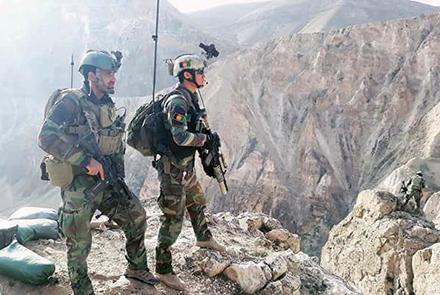The Special Investigator General for Afghanistan Reconstruction (SIGAR) has reported that the Taliban’s control of districts as of the end of January remains virtually unchanged.
According to SIGAR’s latest report, the Taliban continues to maintain its grip on half of Afghanistan, despite US military’s reinvigorated effort to force the group from its strongholds.
Accordingly, early 2018 has already seen an increase in the number of US air strikes conducted in Afghanistan.
The US air force dropped 378 munitions in January, 469 in February, and 339 in March 2018 during 215 missions.
The total of 1,186 munitions dropped in the first quarter of 2018 is the highest number recorded for this period since reporting began in 2013, and is over two and a half times the amount dropped in the first quarter of 2017.
According to the SIGAR report, the Afghan government controls or influences 229 of Afghanistan’s 407 districts (56.3 percent). The Taliban controls or influences 59 districts (14.5 percent). The remaining 119 districts (29.2 percent) are contested.
There is little change between this quarter and last, when a US military spokesman noted that “approximately 56 percent of the country’s 407 districts are under Afghan government control or influence, 30 percent remain contested, and approximately 14 percent are now under insurgent control or influence.”
The report also noted the record high security incidents in 2017.
The Secretary-General of the United Nations (UN) reported in late February that the security situation in Afghanistan remained highly unstable as conflict between government and insurgents continued throughout the country and high-profile attacks in urban centers increased.
The UN reported 23,744 security incidents during 2017, the most ever recorded, but only a negligible increase from 2016. Armed clashes continued to cause the most security incidents (63 percent of incidents), roughly on par with 2016, followed by improvised explosive devices (IEDs) and air strikes.
The UN said that the 950 air strikes recorded in 2017 represented a nearly 68 percent increase compared with the same period in 2016, though the US Air Force’s figure (4,361 strikes during 1,248 missions) is significantly higher. Notably, suicide attacks increased by 50 percent, and targeted killings and abductions increased by 6 percent compared with 2016.
The eastern and southern regions of Afghanistan continued to experience the highest number of security incidents in 2017, comprising 55 percent of the total.
Civilian Casualties in Early 2018
The report mentioned that UNAMA also reported a very slight increase in civilian casualties recorded from January 1 through March 31, 2018, compared to the same period in 2017.
UNAMA remarked that civilian casualties remain at the high levels recorded during the first quarter of the last two years: there were 2,258 casualties (763 deaths and 1,495 injuries) in the first quarter of this year, 2,255 over the same period in 2017, and 2,268 in 2016.
In a change from previous years, suicide IEDs and complex attacks were the leading cause of civilian casualties thus far in 2018 (33 percent of casualties), followed by ground engagements (30 percent) and non-suicide IEDs (12 percent).
During the first quarter of 2018, UNAMA “note[d] with concern” that the number of civilian casualties caused by anti-government elements had increased significantly.
Anti-government elements caused 67 percent of civilian casualties, a 6 percent increase from the same period last year. Of these, 50 percent were attributed to Taliban, 11 percent to IS-K, 4 percent to unidentified anti-government elements (including self-proclaimed Daesh), and 2 percent to fighting between antigovernment groups.
Anti-government attacks which deliberately targeted civilians accounted for 39 percent of all civilian casualties, more than double last year’s recorded amount.
Pro-government forces caused 18 percent of all civilian casualties in the first three months of 2018, a 13 percent reduction when compared to the same period in 2017.
Of these, 11 percent were attributed to the ANDSF, 2 percent to international military forces, 4 percent to undetermined pro-government forces, and 1percent to pro-government armed groups.
Also notable was that civilian casualties from ground engagements decreased by 15 percent, and child casualties (583, including 155 deaths and 428 injuries) decreased by 23 percent compared to last year.
ANDSF Strength Declines Sharply
From 2017 This quarter, US Forces Afghanistan (USFOR-A) provided the authorized and assigned-strength levels for the Afghanistan National Defense Security Forces (ANDSF) (including the ANA, AAF, and ANP) in an unclassified format. According to USFOR-A, as of January 31, 2018, the authorized strength, or the force level authorized in the tashkil, was 340,300, including civilians.
This is 18,211 fewer personnel than authorized during the same period last year, mainly due to large cuts in authorized personnel for the ANP (21,977).
USFOR-A also reported that the actual assigned strength of the ANDSF as of January 2018 (not including civilians), was 296,409, which includes 165,622 personnel in the ANA and AAF as well as 130,787 in the ANP. This means that the ANA was at 85.4 percent of its authorized strength, and the ANP was at 93.4percent of its authorized strength.
These figures represent a sharp decline in strength from the same period last year: a total of 35,999 fewer personnel in January 2018 compared to January 2017.


